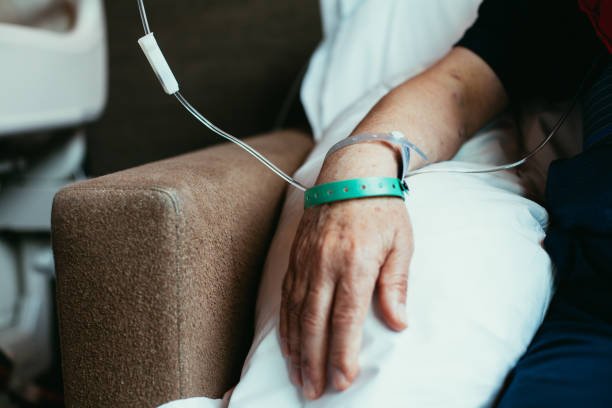There is a whole range of drugs that are approved for the chemotherapy of different types of cancer. What they all have in common is that they inhibit cell division. Cytostatics attack cancer cells at different stages of the proliferation cycle. Therefore, doctors combine multiple drugs to target as many cancer cells as possible at different growth stages.
Cytostatics – examples of drug groups
Anthracyclines break down the genetic material of cancer cells and alter the cell membrane. They are particularly effective because they also work outside the cell division phases. However, they also have many side effects. Anthracyclines include doxorubicin and epirubicin. For example, for breast cancer, doctors often use chemotherapy with epirubicin, cyclophosphamide (EC), and paclitaxel (a taxane). The entire scheme is then called ETC.
Taxanes are of plant origin and come from the yew bark. Taxanes attack the “distribution stations” for the genetic material in the cell, the microtubules. The chemotherapeutic agents stiffen the threads of the microtubules and thus stop cell division. Paclitaxel and docetaxel are commonly used drugs from this class.
Vinca alkaloids come from the periwinkle plant. Like taxanes, they exert their effect on the microtubules and intervene in cell division. Vinblastine and vincristine belong to the vinca alkaloids.
Alkylating agents combine with the genome of the cell nucleus, link the DNA strands together or split them. In this way, they ensure that the cell cannot pass on its genetic information during cell division. Representatives of the alkylating agents are cyclophosphamide or platinum-containing cytostatics such as cisplatin and carboplatin.
Antimetabolites are similar to endogenous substances that occur in metabolism. They bind to various proteins or integrate into the genetic material. This is how they interrupt cell division. Active ingredients from this group are, for example, 5-fluorouracil (5-FU), gemcitabine or capecitabine.
Topoisomerase inhibitors act on certain enzymes that take on important tasks in cell division – the topoisomerases. The cytostatics ensure that the genetic material can no longer be put together after it has been reproduced. Fractures occur; the cell can no longer divide and dies. The drugs are mainly used in advanced cancer. Active ingredients are, for example, topotecan or etoposide.
Chemotherapy drugs – how doctors administer them
Infusion (the most common case): Doctors inject the cytostatics into the vein. The active ingredients spread quickly throughout the body. This is how you catch cancer cells that are circulating somewhere in the organism. Cytostatics are very aggressive substances and can damage the veins. Therefore, many cancer patients have a port placed before chemotherapy. In a brief procedure, a doctor implants a metal or plastic chamber near the collarbone. This has a small tube that opens into a large vein in the body. The veins (on the arm) are spared. In addition, the risk of the medication penetrating the tissue is reduced. You must have a port flushed regularly with saline solution after chemotherapy so that it does not become blocked. It can stay in the body for a long time.
Tablets or capsules: Some chemotherapy can also be used in the form of tablets, for example for breast cancer, colon cancer or stomach cancer. Patients then take them regularly by mouth (orally). The advantage: You do not have to go to the doctor’s office or clinic for the infusion and you are more flexible and independent in terms of time. The disadvantage: the drugs are difficult to dose because the active ingredients are absorbed through the digestive tract and thus get into the bloodstream. But every patient has an individual metabolism. The tablets often contain the precursor of a cytostatic, which the organism then converts into the actually effective form. One example is capecitabine, which the body converts into the cytostatic 5-fluorouracil (5-FU).
Local: Chemotherapy, for example for skin cancer, can also be applied to the skin as a cream or ointment. Local chemotherapy is also possible for liver metastases, for example. In transarterial chemoembolization (TACE), the active ingredients are directed into the liver via the hepatic artery, where they target malignant tumors locally. For brain and spinal cord tumors, doctors often give chemotherapy into the spinal canal. The drugs then only reach the regions that are connected to the canal in the spinal cord, such as the brain and meninges.
Does methadone help against cancer?
There are numerous reports in the media about the effects of the opioid methadone on cancer. The background: A chemist from Ulm went public in 2017 with the statement that methadone can increase the effect of chemotherapy and destroy cancer cells – but so far only in the laboratory. The German Society for Hematology and Oncology (DGHO) states the following about the use of methadone in cancer treatment: It has been proven many times that methadone has a good pain-relieving effect. On the other hand, there is currently insufficient evidence for an antitumoral effect on cancer.


